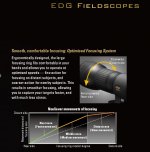Alexis Powell
Natural history enthusiast

Alexis:
I suppose we all have a wish list, and I have seen you wanting some
makers to offer a variable ratio focuser.
I feel that is a complex requirement that I or most do not have a need
or want for. Keep things dependable and reliable.
Swarovski, if you are watching, I would not put this anywhere near the
list of things to do.
Alexis, the Brunton Epoch is now on a clearance sale and this model has a variable ratio focuser.
Discontinued and gone.
So there is your wish. :smoke:
Jerry
I'm really only advocating for variable-ratio in bins with close focus, especially those supposedly no-compromises super-bins like the SV and SF where the designers have taken the trouble to give them super close focus ability. However, variable-ratio focus would be of great benefit to many other bins, and many other users (see end of last paragraph, below), so I hope others will take up the cause when they realize what it could do for them.
The SV and SF designs are awesome, but since they have a fairly standard (SF) or slow (SV) focus ratio, the benefit of the close focus is not fully realized (for the SF) or severely compromised (for the SV) for those who would actually use it continually (e.g. butterflyers). Those bins have almost reached the pinnacle of what is possible with existing (and non-electronic) technology, but unfortunately are half-baked designs with respect to utility of their close focus. Frankly, I think Swarovski and Zeiss should be EMBARRASSED for its absence, just as they should be embarrassed to have taken so long (~30 years after Nikon, and much longer since advent of the technology) to offer flat-field bins for birding. These top-end bins are, like sports cars, as much or more about corporate prestige (bragging rights) as they are about meeting practical needs, so I don't think the bino makers should hold back just because folks who use bins like I do are a small percentage of potential buyers (Likewise, folks with IPD under 56 mm are only a few percent of buyers, but if bins can be built to accommodate them without much trouble, I'd like to see it done).
The FL hit a sweet spot in my opinion with respect to its close focus ability and focus ratio. The SV, SF and similar would do well to follow its example, or better yet, incorporate variable-ratio. I don't understand why variable-ratio design needs to be complex or add cost. I don't think it has to be. Brunton, Pentax, and Minox have all come out with reliable variable-ratio models, none of them priced above the conventional focus competition of the same overall quality. The Brunton Epoch (at least the older versions and more recent top-end versions) has a beautiful focus, but unfortunately the overall optical performance is not quite as good as that of Zeiss or Swarovski. And for butterflying, the Epoch has a big flaw in having a very narrow FOV and so little field overlap at close distances. Now that the Epoch is gone, it is the perfect time for Swarovski, Leica, Zeiss or Nikon to finally use it since they can market it as a new, unique feature.
I know variable-ratio focus isn't something that most buyers are asking for, but I think that mostly has to do with ignorance of what it is, or that it is possible. Brunton had a hard time marketing the advantages to its clientele, and never effectively reached out to the potential consumer constituencies that would most benefit. Minox and Pentax haven't even tried to market it. Who benefits from variable-ratio? In tandem with close-focusing design, it is butterflyer+birders like me, or those who use bins similarly, who have the most to gain. But more generally, anyone with poor accommodation (e.g. old people) should appreciate the design since it eliminates the usually inevitable trade-off between focusing speed and focusing precision across a bin's focus limits. It would be a really nice feature for high-powered bins, as it would allow dialing in the focus near infinity very precisely without compromising the ability to quickly focus on subjects at mid-range distances. So in my dreams, I can picture a consumer coalition between butterflyers and long-distance rifle hunters/varmint shooters in advocating for variable-ratio focus in bins!
--AP
PS -- Looks like Nikon agrees with Brunton, Minox, and Pentax about the virtues of variable-ratio focus. I just received a private message pointing out that the Nikon EDG scopes are equipped as such. I can't believe I never noticed this before, or that no one previously called it to my attention. Check out this excerpt from the catalog (see attached). The graph is maybe a little screwy, but the overall message points to its utility in scopes, just as I argued above for high-powered bins. C'mon Nikon (and Swarovski, Zeiss, and Leica), let's see wider employment of variable-ratio focus in those bins that would most benefit!
Attachments
Last edited:





